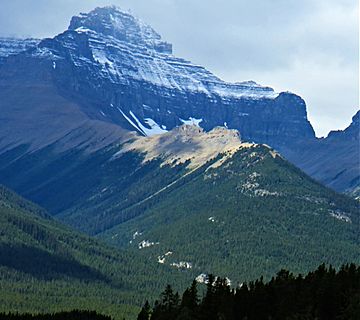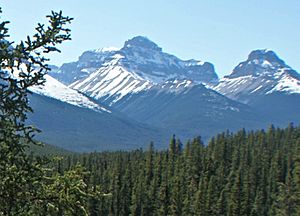Mount Erasmus facts for kids
Quick facts for kids Mount Erasmus |
|
|---|---|

Mount Erasmus seen from the Icefields Parkway
|
|
| Highest point | |
| Elevation | 3,265 m (10,712 ft) |
| Prominence | 735 m (2,411 ft) |
| Parent peak | Mount Lyell (3498 m) |
| Listing | Mountains of Alberta |
| Geography | |
| Location | Alberta, Canada |
| Parent range | Lyell Group, Central Icefields Canadian Rockies |
| Topo map | NTS 82N/15 |
| Type of rock | Sedimentary |
| Climbing | |
| First ascent | 1950 J. C. Oberlin, F. D. Ayres |
| Easiest route | Mountaineering |
Mount Erasmus is a tall mountain located in Banff National Park, Alberta, Canada. It stands 3,265 meters (about 10,712 feet) high. This impressive peak is part of the Canadian Rockies, a huge mountain range. You can see Mount Erasmus from the Icefields Parkway. It looks especially great for photos in the morning light. The mountain is found in the North Saskatchewan River valley. Its closest higher peak is Mount Amery, which is about 9.41 kilometers (5.85 miles) away to the north-northwest.
The Story Behind Mount Erasmus
Mount Erasmus got its name in 1859. It was named by James Hector during the Palliser expedition. The mountain honors Peter Erasmus (1833-1931). He was a very important interpreter and guide for that expedition. Peter was a Métis person. His language skills helped explorers and scientists understand the western lands.
The first people to climb Mount Erasmus were John C. Oberlin and Fred Ayres. They reached the top in 1950. The name "Mount Erasmus" became official in 1957. This decision was made by the Geographical Names Board of Canada.
How Mount Erasmus Was Formed
Mount Erasmus is made of sedimentary rock. This type of rock forms from layers of sand, mud, and shells. These layers were laid down in shallow seas a very long time ago. This happened during the Precambrian to Jurassic periods. Later, huge forces pushed these rocks eastward. This event is called the Laramide orogeny. It caused the older rock layers to slide over younger ones. This process helped create the towering mountains we see today.
Weather and Climate
Mount Erasmus is in a subarctic climate zone. This means it has cold, snowy winters. The summers are usually mild. Temperatures can drop very low, sometimes below -20 °C. With wind, it can feel even colder, below -30 °C.
The best time to climb Mount Erasmus is during the summer months. This is when the weather conditions are most favorable. All the rain and melted snow from Mount Erasmus flows into streams. These streams then join the North Saskatchewan River.





